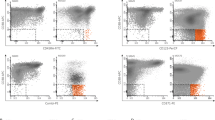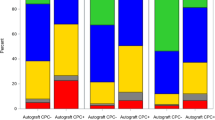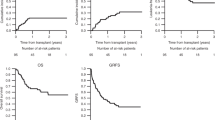Abstract
We evaluated 18 acute myeloblastic leukaemia (AML) and myelodysplastic syndrome (MDS) patients with abnormal karyotype at diagnosis who underwent peripheral blood stem cell (PBSC) transplantation. To evaluate the presence of residual tumour cells, bone marrow (BM) samples and PBSC collections were analysed by cytogenetics and in selected cases also by fluorescence in situ hybridisation (FISH) and molecular studies. All patients were considered to be in morphologic and cytogenetic complete remission (CR) at the time of mobilisation. Seven patients showed neoplastic cells in PBSC harvest and/or BM specimen before reinfusion. Cytogenetic studies revealed contamination in apheretic collections in one patient only, while three patients had BM but not PBSC contamination. Three more patients had leukaemic cells both in the BM and PBSC. All but one (with only BM contamination) of these patients relapsed within 9 months. However, five more patients relapsed after transplantion: in four cases there was no cytogenetic sign of contamination either in PBSC or BM cells and in one case no molecular evidence was revealed either. This study suggests that, whereas the presence of leukaemic cells in autologous grafts correlates with a poor prognosis, the lack of detection of tumour cells is not always predictive of long-term disease-free survival. More importantly, PBSC collections from AML patients are not contaminated by leukaemic cells if the BM is disease-free.
This is a preview of subscription content, access via your institution
Access options
Subscribe to this journal
Receive 12 print issues and online access
$259.00 per year
only $21.58 per issue
Buy this article
- Purchase on Springer Link
- Instant access to full article PDF
Prices may be subject to local taxes which are calculated during checkout
Similar content being viewed by others
Author information
Authors and Affiliations
Rights and permissions
About this article
Cite this article
Testoni, N., Lemoli, R., Martinelli, G. et al. Autologous peripheral blood stem cell transplantation in acute myeloblastic leukaemia and myelodysplastic syndrome patients: evaluation of tumour cell contamination of leukaphereses by cytogenetic and molecular methods. Bone Marrow Transplant 22, 1065–1070 (1998). https://doi.org/10.1038/sj.bmt.1701491
Received:
Accepted:
Published:
Issue Date:
DOI: https://doi.org/10.1038/sj.bmt.1701491
Keywords
This article is cited by
-
Molecular measurement of BCR-ABL transcript variations in chronic myeloid leukemia patients in cytogenetic remission
BMC Hematology (2010)
-
Double reinforcement with fludarabine/high-dose cytarabine enhances the impact of autologous stem cell transplantation in acute myeloid leukemia patients
Bone Marrow Transplantation (2001)
-
Alpha-interferon improves survival and remission duration in P-190BCR-ABL positive adult acute lymphoblastic leukemia
Leukemia (2000)



